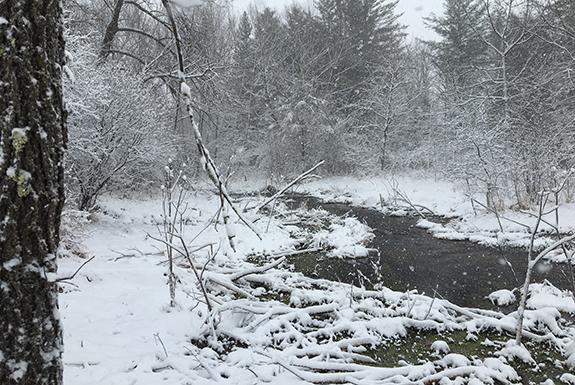Spending time in trout streams becomes a necessity now that the early season is underway. Preparation is not difficult considering there is a mild weather day about once a week. A heavy fleece under a fishing vest and wet flies last used on the January opening weekend is sufficient. Snow along the trail is just deep enough and freshly covered in white to give a wintery feel to the valley.
From a distance the stream below appears like a dark ribbon meandering in sharp contrast with the snow among bare trees. Closer, the stream takes on the appearance of being alive as current flows over rocks green with mosses, and between islands of water cress. Tiny midges flitting about over the stream are not harassed on the surface by trout today.
To understand what trout will seek as food in many cases is most easily done by collecting bugs from submerged rocks and tree branches. To the trained eye, the kinds of bugs found reveal the preferred food choices of trout for months to come. In this case it was like reading a calendar of the main hatches for the next five months. Examining the submerged leaf packs draped over tree limbs discloses midge larvae that will hatch as adults in February. Also found are Winter Stoneflies that will hatch and crawl from the streams in March and April. Rocks pulled from riffles are covered with numerous Hendricksons that will fly from the streams in April and May. The larvae of Grannom caddisflies, that cling to submerged branches, will be on the wing in April to be followed by the mayfly March Brown and Spotted Sedges caddisfly in the month of June.
There it is, the fishing plan for the forthcoming season revealed in the form of bugs found in streams in early February. These bugs are immature and small in size but will grow and hatch from streams like clockwork in the next months.
This is an outstanding line-up for the coming seasons that only hint at the diversity of the macroinvertebrate community, the bug community, common to Central Wisconsin trout streams. Within many of these bug groups e.g. caddisflies and mayflies, there are numerous species. These species have an ecological function, which is to transform plant energy, that has been energized by sunlight, into trout biomass. Bugs have marvelous ways of transforming energy through different kinds of feeding behaviors. Grannom caddisfly larvae feed by filtering drifting algae from flowing water. Their legs have bristle-like combs, that when extended into the passing water currents, strain algae from flowing water. Spotted Sedge caddisflies are also filter-feeders; however, like spiders they construct a net made of silk to collect bits of plants and algae that drift along stream bottoms.
March Brown mayflies crawl about grazing on diatom and periphyton growing on rock surfaces. They have specialized mouth structures designed for scraping algae. The Winter Stoneflies do their part in the transfer of energy by consuming tree leaves that accumulate within stream riffles and side channels. Leaves become softened and covered with bacteria and fungus growth that attract stoneflies. The skeletonized leaves common in streams are evidence of these activities.
In February trout streams may appear stark and cold when viewed from the warmth of a car traveling the roads of Central Wisconsin. But take a moment to stop at a bridge crossing sometime and imagine the wildlife of a stream and its trout. Better yet, wader-up and enter the world of trout stream wildlife and experience moments important to life.


